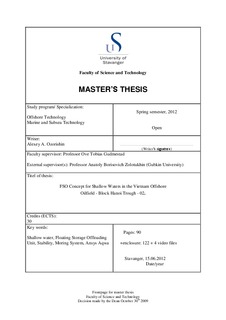| dc.contributor.author | Ozorishin, Alexey | |
| dc.date.accessioned | 2012-10-16T14:10:50Z | |
| dc.date.available | 2012-10-16T14:10:50Z | |
| dc.date.issued | 2012 | |
| dc.identifier.uri | http://hdl.handle.net/11250/182918 | |
| dc.description | Master's thesis in Offshore technology | no_NO |
| dc.description.abstract | Storage and offloading are integral parts of any oil and gas development project. This issue is more difficult and complex for offshore fields, because all or most parts of the equipment are located in the sea.
For Block Hanoi Trough - 02 there is no exception. All equipment is planned to be installed in the sea. However, FSO is the only floating unit in this oilfield. FSO is the cheapest solution, due to absence of the onshore infrastructure. However, cheapest solution does not mean the simplest one. Shallow water and severe weather conditions create challenges for a vessel. An unwanted development of events might have a catastrophic consequence.
The most input data regarding weather conditions and production rate are analyzed in the first part of the Thesis. Further general aspects of vessel such as types of hull, blocks of FSO, types of mooring systems are discussed in second part of the Thesis.
Last part is dedicated to engineering calculations. An FSO model is built using computer aided engineering systems FastShip and Solidworks. Model has natural sizes, including the volume of tanks and realistic mass properties. To evaluate wind loads a superstructure was build. Further model was exported to hydrodynamic system Ansys Aqwa 14, which is based on finite element model grids. Extreme weather data were the model input. Hydrostatic and hydrodynamic parameters of stability such as response amplitude operator were estimated. Also 2 possible mooring system designs were appreciate. Chains and anchor were calculated based on evaluating data. To reach the technical tasks international standards were used. All the necessary information about the weather data, area conditions and oilfield is provided by the oil company “Lukoil Overseas”.
Conclusions summarize the obtained results, give a recommendation for increasing stability and reducing possible emergency situations. | no_NO |
| dc.language.iso | eng | no_NO |
| dc.publisher | University of Stavanger, Norway | no_NO |
| dc.relation.ispartofseries | Masteroppgave/UIS-TN-IKM/2012; | |
| dc.subject | shallow water | no_NO |
| dc.subject | floating storage offloading unit | no_NO |
| dc.subject | stability | no_NO |
| dc.subject | moring system | no_NO |
| dc.subject | Ansys Aqwa | no_NO |
| dc.subject | offshore teknologi | no_NO |
| dc.subject | undervannsteknologi | no_NO |
| dc.title | FSO concept for shallow waters in the Vietnam offshore oilfield - block Hanoi trough - 02 | no_NO |
| dc.type | Master thesis | no_NO |
| dc.subject.nsi | VDP::Technology: 500::Marine technology: 580::Offshore technology: 581 | no_NO |
